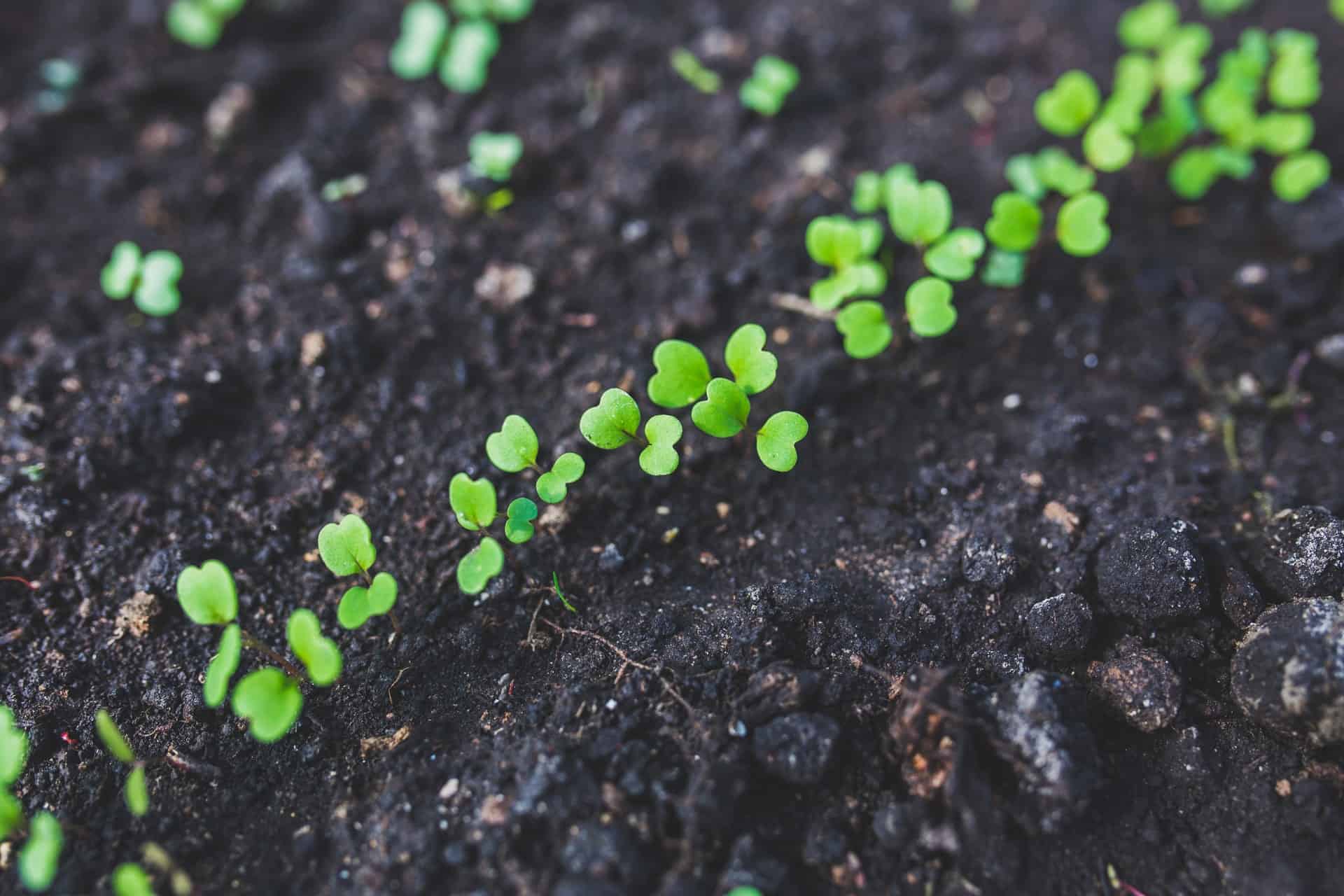Soil is remarkable thing. Nothing more than a thin blanket that exists between sterile rock and the sky, soil supports all life and is itself, in some measure, the product of living things.
It’s the most underrated element of gardening.
And unless you’re a farmer or a commercial grower, chances are you lay out your garden in the most convenient spot and make the best of whatever soil happens to be there. But even if what happens to be there is less than ideal, there’s a lot you can do to turn it into a healthy, productive garden.
Understanding soil and how plants grow in it will help you make the most of what you’ve got right there in your own yard.
How Soil Works With Your Plants
Essentially the function of the soil in relation to the plants that grow in it is fourfold: It must supply water; it must supply nutrients; it must supply gases (carbon dioxide and oxygen); and it must be firm enough to support the plant securely.
The ideal soil is a middle-of-the-road mixture, holding moisture and nutrients while letting excess water drain away to make room for air. Don’t make the mistake of assuming that your garden contains only one type of soil; several different soils can exist in one backyard. Each natural soil is composed of fine rock particles, organic matter, and microorganisms.
A good soil is 50 percent solids and 50 percent porous space, which provides room for water, air, and plant roots. The solids are 80 to 90 percent inorganic matter and 10 to 20 percent organic materials. Water and air should each occupy about half of the porous space.
Types of Soil
There are four basic types of soil, and the texture of each is determined by the different proportions of various-sized soil particles. These four types of soil are clay, sand, silt, and loam.
Clay Soil
A clay soil is composed of particles that are less than 1/31750 of an inch (1/200 mm) in diameter. These minute particles pack together more closely than larger particles and have a greater total surface area.
Clay soil can hold more water than other soils. It often drains poorly, but drainage can be improved by the addition of organic matter to break up the clay particles.
If you try to work with a clay soil when it’s wet, you’ll compress the particles even more closely; then, when the soil dries, you’ll be left with a surface something like baked brick or concrete. Properly managed, however, clay soils can be the most productive of all.
Sandy Soil
A sandy soil is made up mostly of particles that are over 1/3175 of an inch (1/20 mm) in diameter. They are much larger than clay particles and irregular in shape, so they don’t pack as closely together as clay particles.
Because they have less total surface area, these larger particles hold less water than smaller particles and are much more porous. Sandy soil drains like a sieve, but can be improved by the addition of organic matter, which helps retain moisture and nutrients
Silt Soil
In a silt soil the size of the particles is intermediate — between clay and sand. Depending on the size of its particles, a silt soil can act either like a clay soil or like a fine sandy soil.
Silt consists of small, gritty particles that can pack down very hard, and it’s not very fertile. Silt soil is often found on top of heavy clay, which slows or stops drainage.
Loam
Loam is a mixture of clay, silt, and sand particles. A good garden loam is something to cherish, particularly if it also contains a heavy supply of organic matter.
All soil improvement is aimed at achieving a good loam — when you add organic matter or make other improvements to your clay or sandy soil, you’re trying to provide the type of loam that lucky gardeners have without all that extra work
Simple Touch Test of Soil Mixture
The best way to determine the approximate texture of the soil in your garden is by feeling it with your hands. Try this test: Take a small handful of moist garden soil, and hold some of the sample between your thumb and the first knuckle of your forefinger.
Gradually squeeze the soil out with your thumb to form a ribbon. If you can easily form a ribbon that holds together for more than one inch, you have a very heavy clay soil. If a ribbon forms, but it holds together for only three-quarters of an inch to one inch, your soil is a silty clay loam.
If the ribbon forms but breaks into pieces shorter than three-quarters of an inch, you have a silty soil. If a ribbon won’t form at all, you have a sandy soil.
Improving Your Garden Soil
Unless you’re one of the lucky people with a garden full of rich, productive loam, it’s probable that you will want to improve your soil in the interests of harvesting a bigger and better crop of vegetables at the end of your growing season.
When you’re planning your soil-improvement program you have to take two issues into account: the texture of the soil and the nutrient content of the soil. You can improve both quite easily.
Improving Soil Texture
The physical texture of any soil can be improved by the addition of large amounts of organic matter. You can use materials like ground corncobs, sawdust, bark chips, straw, hay, peat moss, and cover crops; it’s a great way to recycle a lot of garden wastes.
You can use grass clippings, provided the lawn has not been treated with a herbicide or weed killer; these substances will damage the plants you want to grow. Also avoid walnuts or walnut leaves. They contain iodine, which is a growth retardant.
Making your own compost pile gives you excellent organic matter to enrich the soil and will be discussed later in this chapter. The more organic matter you add, the more you can Improve the texture of the soil. Blend the organic matter into the soil to a depth of 12 inches, making sure that it’s evenly dispersed through the whole planting area.
When organic matter is added to the soil, it will absorb some of the soil’s nitrogen; to compensate for this, you should add two handfuls of a complete, well-balanced fertilizer (10-10-10) for each bushel of organic matter, working it thoroughly into the soil.
Improving the Nutrient Content of Your Garden Soil
The next step in your soil-improvement program is to have the soil tested to identify deficiencies — unless you correct those deficiencies, they can cause poor plant growth.
In some states the Cooperative Extension Service will act as middleman and send your soil sample to the laboratory for you; in all states the extension service can give you information on firms in your area that do the tests. Either way, you will be charged a fee for the test.
The other option is to purchase one of the many test kits available online or at garden center. They’re anywhere from $10 to $60. Complete kits typically test nitrogen, phosphorus, potassium and pH, which are the most important basics.
I hasten to add that although these test kits and meters may seem like the perfect alternative to lab testing, they typically aren’t as accurate. Several studies have evaluated some of the various test kits available to home gardeners and have found that some are more accurate than others, and that accuracy can vary depending on which nutrient is being tested for.
In any case, the results of the soil test will give you the pH (acid-alkaline balance) of the soil and its content of three essential nutrients: nitrogen (N), which promotes leafy growth (although too much nitrogen will encourage too much foliage growth and slow down crop ripening); phosphorus (P), which is important for root growth and the production of flowers, fruits, and seeds; and potassium (K), which is necessary for the development of leaves and roots.
The pH is measured on a scale of 1 (most acid or sour) to 14 (most alkaline or sweet), with 7 representing neutral. Most vegetables do best in soil that has a pH between 5.5 and 7.5, and most of them prefer soil to be on the acid side of neutral.
How to Take a Soil Sample
Soil samples can be taken any time of the year, as long as the ground isn’t frozen hard. Use a plastic bucket instead of metal, especially if the soil sample is to be used for testing micronutrients.
You’ll also need a digging tool, such as a spade or a trowel, and a clean container (a carefully washed-out one-pint milk carton or the container provided by the testing service). All equipment should be perfectly clean. If there’s any grass on the spot you’re sampling, remove it.
Then take a slice of soil half an inch thick and about eight inches deep straight down from a number of locations throughout your garden. If you’re sampling a large area, 20 samples mixed together will do as fine a job as 40 or100. if your garden is small, a minimum of five samples will be enough.
Place all the samples in the plastic bucket, and then mix them thoroughly. If the soil is very wet, let it airdry before mixing. Do not heat it in the oven or on a radiator; heat will kill the microorganisms and cause nitrogen and other elements to change form, making the test inaccurate.
If there are a lot of lumps, crush them with a wooden spoon or a rolling pin on a wooden surface. After the soil is thoroughly mixed, fill your container and follow the laboratory’s instructions for sending the sample.
Adjusting the pH Balance
The results of your soil test will give you the pH balance of the soil.
If you’re lucky, the laboratory may say that the pH is just fine and you need make no adjustment. Or the laboratory may advise you to raise the pH by adding a recommended amount of lime or to lower the pH by adding a recommended amount of a sulfur product — ammonium sulfate is the one most commonly used.
Don’t use aluminum sulfate in your vegetable garden; the aluminum can be absorbed by the plant, making it toxic to you when you eat the vegetable. You can get lime and sulfur products from hardware stores and garden centers; the laboratory report will tell you how much to use and how to apply it.
It’s a good idea to have your soil tested every three to four years to make sure that the pH is in an acceptable range. If you’ve had a problem with the pH, it may be a good idea to test your soil even more often.
This may seem like a lot of work, but good soil is essential to a good harvest, and your care and labor will pay off in higher yields and better quality vegetables

